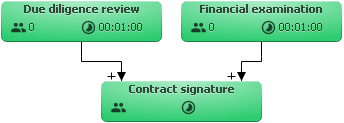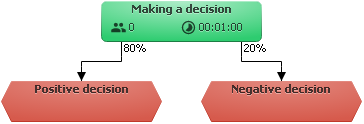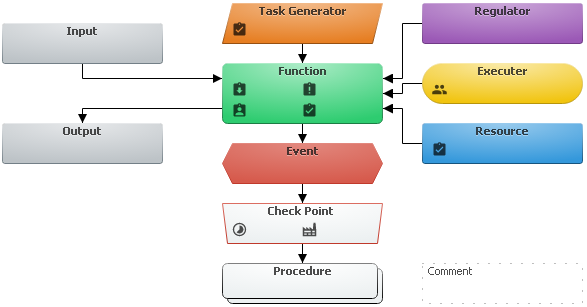Business Process Mapping
Model objects
In the service bpsimulator.com for visual modeling using the original simplified task-oriented notation of business process modeling, compatible with modeling notation such as IDEF03, eEPC and BPMN.
To add a new object to the model you need to press or move of his image from the Control Panel. Objects can be moved over the entire of application workspace. The following table provides a description of all possible objects of the model:
| Object | Description | Example | Properties |
|---|---|---|---|
| General Elements | |||
| Set of targeted actions to be performed by one or more executors in one role |
|
||
| Position or role of those responsible for the execution of the function |
|
||
| Service or tools needed to perform the function |
|
||
| Generator global tasks of the business process of a certain type with a certain interval for the simulation purposes |
|
||
| Auxiliary element for monitoring the process parameters at different stages its execution and control of tasks flow |
|
||
| EPC Elements | |||
| Cause or an intangible result of a function |
|
||
| Regulate document directly related to the order, conditions or results of the function |
|
||
| Material or information necessary to perform the function |
|
||
| Material or information generated or acquired additional properties as a result of the function |
|
||
| Set of performance features for a particular purpose |
|
||
| Auxiliary element model for clarifications or comments |
|
||
Detail level when modeling depends on the purpose of the simulation. For example, to generate regulations of a process required in almost all objects modeling, except Tasks Generator, but for calculating the the costs enough functions and resources: executors and resources.
To delete or copy an object to press the "Delete" or "Copy" on its Properties screen described in the next section.
Object properties
the Properties screen is opened in the Control Panel by double-clicking on the object of model. Listed below are all available properties.
| Property | Type | Description |
|---|---|---|
| Name | Text | Text description of the object. Example of function name: "Payroll preparation" |
| Duration | Number | The minimum and maximum duration of the function. For example, the duration of the function "Processing of details" is from 20 to 30 minutes. |
| Rule distribution of tasks from suppliers | AND/XOR | Logical rule for processing of tasks, received from its predecessors function. If the value is XOR function will be assigned to the execution of tasks on delivery from any predecessor on model. If the value is AND function will not
be executed until by a links of all predecessors functions do not will come the same task. Example:

|
| Rule distribution of tasks to consumer | AND/XOR | Logical rule for distribution of completed tasks to consumers of the function. If the value is AND a completed tasks will be distributed to all customer's functions. If the value is XOR task will be distributed to the consumer with
a certain Probability distribution of tasks to consumer. Example:
 |
| Probability distribution of tasks to consumer | Number | Percentage that determines the probability distribution of tasks to a consumer of the function. The sum of all percent probability distribution of the output of one function must be equal to 100% with value of Rule distribution of tasks to consumer is XOR. |
| Time of delivery a task to consumer | Range | Minimum and maximum value of the time required for transporting completed tasks to the next consumer of the function. For example transfer time from the back-office signed copies of the contract to the customer is from 12 to 24 hours. |
| Cost of the resource per task | Currency unit | In case of set up determines the costs of resource use to perform a single task, regardless of the time spent. For example the delivery of goods by courier to the city costs 200 currency unit. |
| Number of employees | Number | The actual number of staff positions in the organizational structure or appointed as an executive of the functions. For example, 5 employees of call center to answer the incoming calls. |
| Cost of using of the resource | Currency unit | Pay rate hours of operation of the resource. For example, the make-up artist working hour is worth 1000, and lease of cloud storage just 0.0001 of currency unit. |
| Operating periods | Range | The time period available resources to perform the functions. For example, to account for the availability of dinner break necessary two periods: 09:00-13:00 and 14:00-18:00. |
| Tasks count | Number | The number of tasks formed by the generator at a certain period of work. For example, to simulate the arrival rate of new tasks 1 times per minute necessary to set the frequency to 60 tasks per hour. |
| Timing | List | Distribution type of the count of new tasks in the period of the Task Generator. For example, most of the requests could be received at the beginning of each hour. |
| Global priority | Number | Priority of task assignment subject to availability of queued for processing multiple tasks of different types. Such as priority of tasks for debt collection of customers, who the first time overdue. |
| Local priority | Number | Priority of task assignment subject to availability of queued for processing multiple tasks from different previous functions. For example priority for tasks returned for revision. |
| Joint fulfillment | Boolean | To perform a function necessary to assign one by one employee from available resources. For example for piano four hands require two pianist (left and right) together. |
| Filter tasks | List | The list of Tasks Generators tasks of which will be transported to the next object of flow. An empty list allows passing any tasks. |
| Batch Size | Number | The number of tasks created by a generator or executed by a function at a time. For example a blood analyzer loaded one container with 5 tubes with biomaterial. |
| Filling | Boolean | Attribute the need to fully fill the entire batch size of tasks to get started. For example not warm up the oven until it delivered enough material. |
Not necessarily immediately to fill all the available properties of the object. For example, if there is no need to calculate the cost of the process instance then cost parameters of resources do not need to complete.
Links of objects
All objects in the model should be at least one link to another object. To create a link between objects, you must first double-click on the object - the source of links, and then click on the object - the recipient, link will be created with an arrow on the side of the second object. Link means a direct impact or relationship of one object from another. Not all objects can be linked to each other. The group of objects: Tasks Generator, Function, Events, Procedure and Check Point can be suppliers (predecessors) or consumers (followers) of each other. Other objects only as the impact on function, as shown below the diagram:

An "X" and "+" at the beginning or end of the link means allocation rules "XOR" or "AND" accordingly. The numbers at the beginning of the arrows correspond to the value of the Probability distribution of tasks to consumer.
To delete an existing links must be selected by double-clicking one of the objects, all of his links will be displayed as dotted line. When you click on such a link, it will be deleted.
All manipulations with the objects of the model are reversible and can be reversed by a visual component at the bottom of the screen or pressing Ctrl+Z on the keyboard.
Keyboard shortcuts
- Ctrl+C - copy of selected objects to the clipboard
- Ctrl+S - save the model
- Ctrl+V - paste of copied objects
- Ctrl+Z - undo the last action on the object of model
- Ctrl+Shift+Z - redo the last action on the object of model
- Delete, Backspace - remove of selected objects